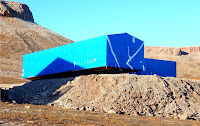I think the early arrival & departure of the Rosaire A Desgagnes ship during sealift was foreshadowing imminent change of weather. (The sealift ships are on a tight schedule and want to get everything done before the start of winter). I woke up to snow falling on the community on September 10. It wasn’t the thick kind of snow; more like the very light snow that immediately melts when it touches the ground. I had to wear a few extra layers under my jacket as I walked to school. I took a few photographs for my digital records. A very thin layer of snow covered the ground, reminding me of a white powdered donut. I assumed the snow would be gone by the afternoon.
Unfortunately, no Terry Fox Run was held on September 15 due to COVID-19 restrictions and the sudden arrival of snow. (No snow was present at last year’s event). The Terry Fox Foundation encouraged participants to do a run of some kind in a safe place and showcase it online. I’m not sure if anyone in Arctic Bay participated. I probably would have if I had a treadmill in my place.
There was still some snow on the ground on September 17. I still had to wear rubber boots because of mud. Snow covered the top half of King George V Mountain and it looked like it was going to stay that way until next summer.
More snow fell the next day. This made me wonder if skidoo season would start early this year. Several of my students asked me if I had started driving my skidoo, to which I replied, “No.” I still didn’t think there was enough snow on the ground.
The
weekend of September 19 & 20 was to be the first cadet field training
exercise of the 2020-2021 Training Year.
However, all cadet activities are shut down until early October by order
of the Department of National Defence.
I spent some time at school on Sunday, September 20, correcting school work and preparing lessons. I took a few more photographs of the snowy landscape, familiar landmarks, a dog that watched me walk by, and three people on a boat out in the bay.
Speaking of boaters, I witnessed something for the first time since arriving in Arctic Bay in 2013. I was walking home from school on September 21 when I noticed many small motorboats in the bay. They were at least two people per boat. The boats were spread out across the bay and the occupants were waiting for something. It didn’t take long for me to figure out that they were hunting narwhals. I immediately took out my camera and started taking pictures. Narwhal hunting usually happens much further away from the community.
The boats suddenly rushed in one direction as I neared the Northern Store. A narwhal must have been spotted and everyone wanted to get it. I’m not sure if the hunters are allowed to use their guns this close to the community. They are most definitely allowed to use harpoons. A small crowd of people watched from the shoreline and the Northern Store. The boats came together in one large mass and then spread out again. The armada sped off in another direction as I entered the Northern Store.
The boaters use VHF marine radios to communicate. Someone on the shoreline had a VHF radio and was listening to the conversations.
The
armada continued the “cat & mouse” game as I left the Northern Store. Since it’s the Arctic, maybe it’s referred to
as the “polar bear & seal” game? I
new that some of my students were on those boats. They had talked about going boating on the
weekend & during the week.
Perhaps, one day, I’ll go boating one time to experience the hunt up close. I’ll just make sure to take Gravol before I board the boat. If the water is rough, seasickness is not far away.




































